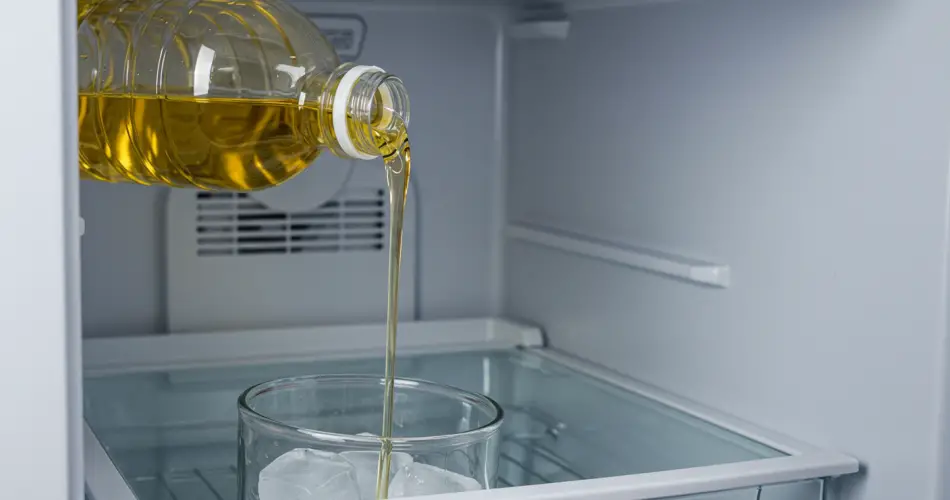Electricity bills can often feel like a heavy burden at the end of the month, especially when appliances such as freezers consume more energy than necessary. Many people are unaware that a neglected freezer, particularly one with excess ice buildup, can significantly increase energy consumption. Fortunately, there are simple, natural methods that can help reduce electricity usage while keeping your freezer efficient and clean. Surprisingly, one of these methods involves a common household item used in the kitchen: oil.
Why Ice Buildup Costs You More
Freezers are essential household appliances, but they require regular maintenance to operate efficiently. Ice accumulation inside the freezer is one of the main reasons your appliance uses extra electricity. When ice builds up along the walls, it acts as an insulator, forcing the motor to work harder to maintain the desired temperature.
A freezer with excessive ice consumes more energy, reduces storage capacity, and can even lead to unpleasant odors or mechanical issues. If left unchecked, these problems can shorten the lifespan of your appliance while increasing your monthly electricity costs.
Step 1: Defrosting the Freezer
The first step in maintaining an energy-efficient freezer is regular defrosting. Experts recommend doing this once a month or, at the very least, every six months. Here’s how to do it properly:
-
Empty the freezer: Remove all food items and store them temporarily in a cooler or another freezer to prevent spoilage.
-
Disconnect the appliance: Unplug the freezer to ensure safety during cleaning and defrosting.
-
Remove ice buildup: You can use a spatula or a plastic scraper to gently remove thick layers of ice. Avoid using sharp objects that could damage the appliance.
-
Optional techniques: Warm water or denatured alcohol can help loosen stubborn ice. A hairdryer can also be used as a last resort if you need a faster defrost, but exercise caution to avoid damaging the freezer’s interior.
Step 2: Cleaning the Freezer
Once the ice is removed, the next step is to clean the interior thoroughly. A clean freezer not only looks better but also reduces bacteria and unpleasant odors.
-
Vinegar solution: Mix white wine vinegar with water and use a microfiber cloth to wipe down all surfaces.
-
Alternative cleaning agents: If you prefer, Marseille soap diluted in warm water can also serve as an effective and natural cleaning solution.
-
Dry thoroughly: After cleaning, make sure to dry all surfaces to prevent moisture from forming new ice.
Step 3: Preventing Ice Buildup with Oil
Here comes the surprising part: using a small amount of oil can prevent ice from forming excessively in your freezer. Both vegetable oil and olive oil work well for this purpose.
-
With the freezer unplugged and cleaned, apply a tiny drop of oil to a clean cloth.
-
Gently rub the oil along the interior walls of the freezer.
-
This thin layer of oil acts as a barrier, reducing the chances of frost forming and helping maintain an optimal environment inside the appliance.
By preventing excess ice, your freezer operates more efficiently, consumes less energy, and avoids the common issues associated with frost buildup.
Additional Tips to Reduce Freezer Energy Consumption
-
Avoid freezing hot food: One of the main causes of ice formation is placing hot or warm food directly into the freezer. The moisture released turns into frost and occupies space, forcing the freezer to work harder.
-
Maintain volume inside the freezer: A completely empty freezer can be less efficient because the cold air circulates unevenly. Keep your freezer moderately full by storing food or filling unused spaces with bottles of water. This helps maintain a stable temperature and reduces energy consumption.
-
Regular maintenance: Inspect door seals to ensure they are tight and replace any that are worn out. Leaky seals allow warm air to enter, increasing frost buildup and energy usage.
-
Defrost regularly: Even with oil and proper storage practices, occasional ice formation is normal. Regularly defrosting ensures the appliance stays efficient and prolongs its lifespan.
The Benefits of This Simple Method
Using just a single drop of oil in combination with regular cleaning and proper storage practices offers multiple advantages:
-
Energy savings: A freezer with less ice consumes less electricity, helping you save money on your monthly bills.
-
Improved appliance lifespan: Reducing stress on the motor and maintaining proper temperature conditions prolongs the freezer’s life.
-
Better storage space: Ice-free walls allow for maximum storage capacity, making it easier to organize and access your food.
-
Hygiene: Regular cleaning removes bacteria and prevents unpleasant odors, ensuring a healthier environment for your frozen food.
Conclusion
Maintaining a freezer doesn’t have to be complicated or costly. By following a simple routine—defrosting, cleaning, applying a drop of oil, and avoiding the freezing of hot foods—you can significantly reduce ice buildup and improve energy efficiency. This small but effective habit not only lowers your electricity bills but also keeps your freezer in excellent condition, providing cleaner, more hygienic, and more organized storage for your food.
Incorporating this method into your household routine is an easy way to save money while taking care of your appliances naturally. Just a tiny drop of oil can make a big difference in reducing frost and keeping your freezer running smoothly. With a little effort, you can enjoy a more energy-efficient and cost-effective home.



